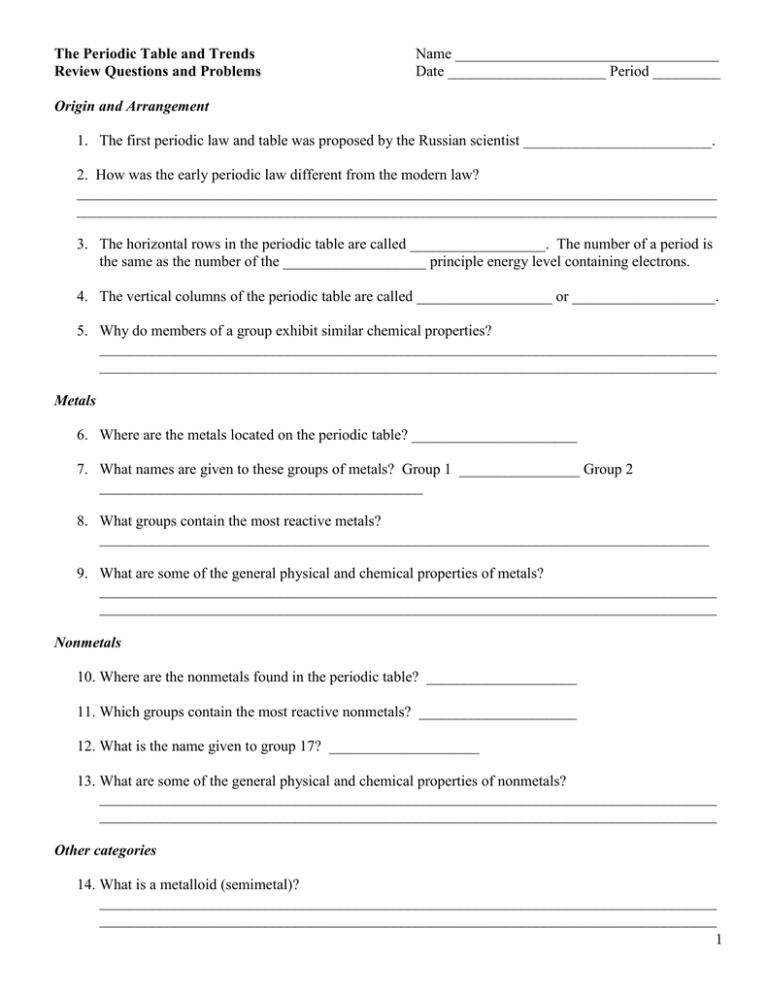Name ___________________________________ Date _____________________ Period _________
advertisement

The Periodic Table and Trends Review Questions and Problems Name ___________________________________ Date _____________________ Period _________ Origin and Arrangement 1. The first periodic law and table was proposed by the Russian scientist _________________________. 2. How was the early periodic law different from the modern law? _____________________________________________________________________________________ _____________________________________________________________________________________ 3. The horizontal rows in the periodic table are called __________________. The number of a period is the same as the number of the ___________________ principle energy level containing electrons. 4. The vertical columns of the periodic table are called __________________ or ___________________. 5. Why do members of a group exhibit similar chemical properties? __________________________________________________________________________________ __________________________________________________________________________________ Metals 6. Where are the metals located on the periodic table? ______________________ 7. What names are given to these groups of metals? Group 1 ________________ Group 2 ___________________________________________ 8. What groups contain the most reactive metals? _________________________________________________________________________________ 9. What are some of the general physical and chemical properties of metals? __________________________________________________________________________________ __________________________________________________________________________________ Nonmetals 10. Where are the nonmetals found in the periodic table? ____________________ 11. Which groups contain the most reactive nonmetals? _____________________ 12. What is the name given to group 17? ____________________ 13. What are some of the general physical and chemical properties of nonmetals? __________________________________________________________________________________ __________________________________________________________________________________ Other categories 14. What is a metalloid (semimetal)? __________________________________________________________________________________ __________________________________________________________________________________ 1 15. List the seven metalloids: __________________________________________________________________________________ 16. Where are the transition metals located on the table? _______________________________________ 17. What characteristic of atomic structure distinguishes the transition elements from the representative elements? __________________________________________________________________________________ __________________________________________________________________________________ 18. Why are the elements in group 18 called inert? __________________________________________________________________________________ __________________________________________________________________________________ Part II: Using Elements 1-14 shown below, answer the following questions. 1 3 6 9 8 2 7 5 13 4 14 10 11 12 1. Element ______ is an alkaline earth metal. 8. Element ______ is a nonreactive gas. 2. Element ______ is in the oxygen family. 9.. Element ______ 4 valence electrons. 3. Element ______ is an alkali metal. 10. Element ______ is in the lanthanide series. 4. Element ______ is a metalloid. 11. Element ______ is a halogen. 5. Element ______ is a gas with 1 valence electron. 12. Element ______ is the only liquid metal. 6. Element ______ is in Period 5. 13. Element ______ is man-made. 7. Element ______ is the alkaline earth metal with the smallest atomic radius. 14. Element ______ has the highest melting point, and its abbreviated configuration is: [Xe]6s24f145d4 2 Review Trends: Summarize the following trends across and down the Periodic Table atomic radius, (AR), ionization energy, (IE), electron affinity, (EA), and electronegativity, (EN) Part III: Practice Problems 1. Circle the atom in each pair that has a larger radius. a. Sn, Sr b. Cl, I c. Na, Rb d. Mg, Be e. S,P f. Pa, U g. B, Al h. Au, Ba i. Mg, Na j. K, Ca k. Al, B l. Br, Cl i. Fe, Fe3+ j. S2-, S k. Se2-, Kr l. Br-, Se2- m. F, N n. Ne, Ar 2. Circle the particle in each pair that has a larger radius. a. Ca, Ca2+ b. F-, Cl- c. As3-, P3d. Pb4+, Pb e. Mg2+, Be2+ g. C, C4f. Te2+, Te h. Ag, Ag+ 3. Predict the oxidation number (charge after the atom gains or loses electrons) for these elements: a. Al b. N c. Cl d. Ca e. Mg f. S g. Na h. C i. Ar j. Be k. K l. Rn 4. How many electrons were gained or lost to produce the following ions? a. K+ b. O2- c. Ga3+ d. P3- e. Sn4+ f. Br- g. Ca2+ h. Sc3+ 5. Circle the atom in each pair that has a lower first ionization energy. a. N, O b. Te, Sn c. Ne, F d. C, Ge e. Br, I f. Mg, Ca g. I, Sb h. Al, N i. F, S 6. Circle the element would have the highest 1st ionization energy? Na, Mg, Al Circle the element would have the highest 2nd ionization energy? K, Ca, Ga Circle the element would have the highest 3rd ionization energy? Be, B, C 3



